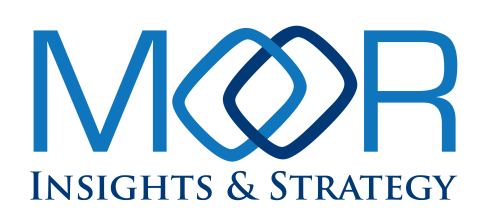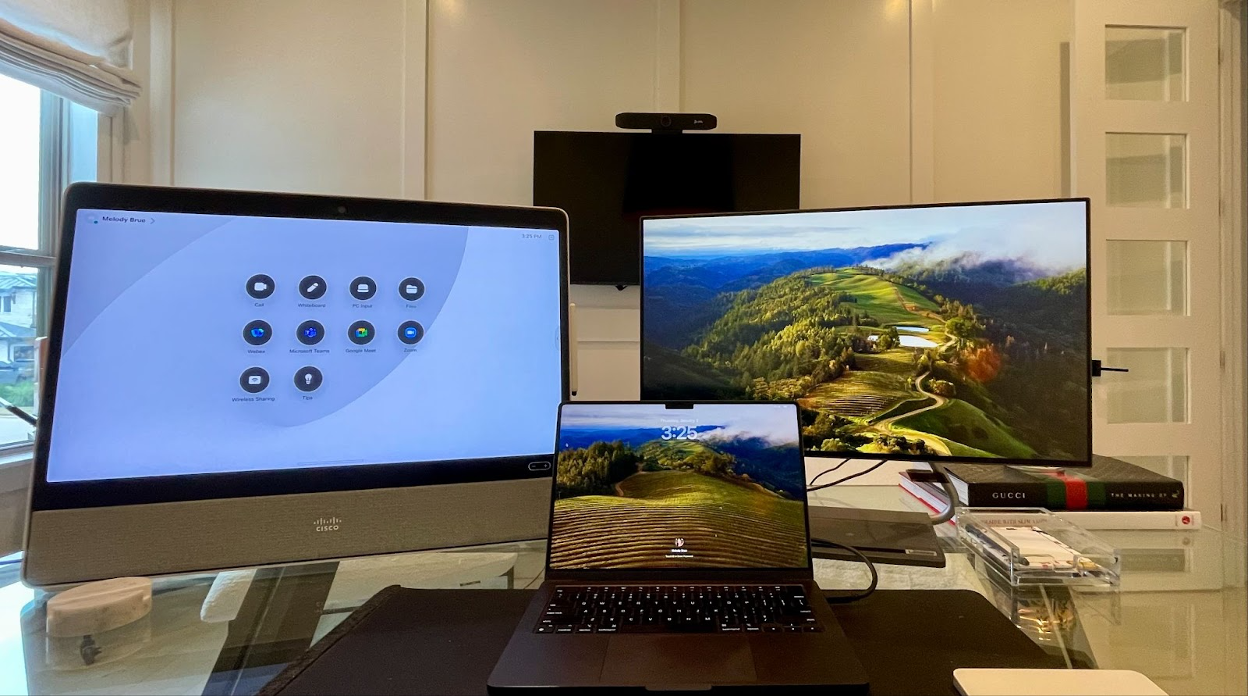
Welcome to this edition of our Weekly Analyst Insights roundup, which features the key insights our analysts have developed based on the past week’s events.
It’s no surprise that my colleagues and I spent much of last week focused on CES. In particular, Anshel Sag—who’s a heck of a device reviewer, besides being a savvy industry analyst—will be publishing a number of pieces this week covering the big PC OEMs, chip makers, and players in the XR industry. Many of my own thoughts from CES made it into Friday’s installment of The Six Five Podcast.

The Cisco Desk Pro (left) is a slick — albeit somewhat pricey — tool for getting more out of your video meetings. Photo: Melody Brue
Plenty of the announcements at CES are about eye-popping (or wannabe eye-popping) consumer devices, but Melody Brue’s review of the Cisco Desk Pro last week is a good reminder of the difference that high-quality enterprise tech can make for individual productivity. This reality is only going to be reinforced by the increasing adoption of AI agents in 2025 to augment the work of corporate employees, from the shop floor to the C-suite.
If you have a piece of new technology that’s changing the way you or your team work in 2025, I’d love to hear about it. What’s your favorite new gadget that’s moving the needle?
This week, Will is at the Cisco AI Summit in Palo Alto and Mel is attending Zoom’s virtual Work Transformation Summit. The rest of us are busy writing, researching, and advising clients. If there is anything we can help you with to start your year off strong, please reach out.
Let’s do this, 2025!
Patrick Moorhead
———
Our MI&S team published 15 deliverables:
This past week, MI&S analysts have been quoted in multiple syndicated top-tier international publications including CIO, Computerworld, Fierce Electronics, Fierce Networks, InfoWorld, MIT Technology Review, TechTarget, Wired, and others. The media wanted our thoughts on AWS, CES, Dell, HPE, IBM, Intel, Nvidia, Oracle, WordPress, and of course AI and some 2025 predictions
MI&S Quick Insights
I was quite intrigued by the agentic blueprints that NVIDIA announced last week at CES. But it was not necessarily the use cases—which were pretty commonplace—that were the real story. Much more compelling was the vision of what agentic development could be. The first thing that stuck out was that these are partner-driven solutions. This is in contrast to what we have seen so far, which have been siloed and internally developed agentic solutions. With those, you basically have to use a homogeneous stack of technology to realize the value. And, yes, there is still a need to use the NVIDIA AI Enterprise platform to deploy the blueprints that were announced, but the simple thought of co-development is good to see—and hasn’t been highlighted enough.
Second, I am very interested in how NVIDIA is thinking about agentic AI in the physical world. That is what I consider a second leap from what we are seeing so far. Today’s agents are very much bound to a cloud or a platform. The first leap I am hoping to see is a leap to the on-premise compute world. This could mean collaboration between the AIs on devices such as an AI PC or an iPhone and the cloud (edge AI, so to speak). The second leap is the same idea but to physical devices and robotics. Again, it’s refreshing to see NVIDIA paint a picture of the agentic world that is so visionary.
Over the past month I have been researching AI development platforms, and I have some research coming out on that very soon. But the deeper I have gotten into the topic, the more I’ve realized that each platform regards different user roles with different priorities. It is almost as if each vendor started development from a completely different place, yet they all ended up close enough to each other that we now have a new category of solution. This is a very good thing early in a product lifecycle. By having a broad base of solutions to choose from, the market will have a better opportunity to judge what ends up being the best use of the technologies.
To that point, I want to mention that the newly released Azure AI Foundry from Microsoft is, to my mind, the first of these platforms to really take on the IT management aspects of the problem set. And while it may not have all of the very coolest developer features we see from the competition, it does highlight an under-represented set of requirements that will be essential for enterprise deployment and success.
Last week a member of the media reached out to me to discuss a topic that got me thinking—how value is being redefined in the age of generative AI. Here’s an example: for as long as we can all remember, having lots of data was critical to drive decision making. And if you had good and exclusive data, that was highly valuable. But now that AI can assemble and infer data so quickly and so well, has the value moved away from mere data possession towards reasoning and prediction? Or will people now go to greater lengths to hoard the best data? I am leaning towards reasoning winning the day, but I do think it’s a great topic for reflection. (I’ll let you know when the article comes out.) At the very least, I expect that we will see a more distinct break between data and reasoning in the business world—like we already do between training and inference within AI.
I was quite intrigued by the agentic blueprints that NVIDIA announced last week at CES. But it was not necessarily the use cases—which were pretty commonplace—that were the real story. Much more compelling was the vision of what agentic development could be. The first thing that stuck out was that these are partner-driven solutions. This is in contrast to what we have seen so far, which have been siloed and internally developed agentic solutions. With those, you basically have to use a homogeneous stack of technology to realize the value. And, yes, there is still a need to use the NVIDIA AI Enterprise platform to deploy the blueprints that were announced, but the simple thought of co-development is good to see—and hasn’t been highlighted enough.
Second, I am very interested in how NVIDIA is thinking about agentic AI in the physical world. That is what I consider a second leap from what we are seeing so far. Today’s agents are very much bound to a cloud or a platform. The first leap I am hoping to see is a leap to the on-premise compute world. This could mean collaboration between the AIs on devices such as an AI PC or an iPhone and the cloud (edge AI, so to speak). The second leap is the same idea but to physical devices and robotics. Again, it’s refreshing to see NVIDIA paint a picture of the agentic world that is so visionary.
Over the past month I have been researching AI development platforms, and I have some research coming out on that very soon. But the deeper I have gotten into the topic, the more I’ve realized that each platform regards different user roles with different priorities. It is almost as if each vendor started development from a completely different place, yet they all ended up close enough to each other that we now have a new category of solution. This is a very good thing early in a product lifecycle. By having a broad base of solutions to choose from, the market will have a better opportunity to judge what ends up being the best use of the technologies.
To that point, I want to mention that the newly released Azure AI Foundry from Microsoft is, to my mind, the first of these platforms to really take on the IT management aspects of the problem set. And while it may not have all of the very coolest developer features we see from the competition, it does highlight an under-represented set of requirements that will be essential for enterprise deployment and success.
Last week a member of the media reached out to me to discuss a topic that got me thinking—how value is being redefined in the age of generative AI. Here’s an example: for as long as we can all remember, having lots of data was critical to drive decision making. And if you had good and exclusive data, that was highly valuable. But now that AI can assemble and infer data so quickly and so well, has the value moved away from mere data possession towards reasoning and prediction? Or will people now go to greater lengths to hoard the best data? I am leaning towards reasoning winning the day, but I do think it’s a great topic for reflection. (I’ll let you know when the article comes out.) At the very least, I expect that we will see a more distinct break between data and reasoning in the business world—like we already do between training and inference within AI.
Sam Altman, CEO of OpenAI, made a very interesting post on his personal blog about when he believes OpenAI could achieve artificial general intelligence (AGI), an advanced level of AI that can perform at human levels. It was only two years ago that OpenAI made the historic launch of ChatGPT. Just two months after its release, ChatGPT had 100 million active users, heralding AI’s potential as one of the most powerful technologies ever created. Beyond that, the launch transformed OpenAI from a small research lab into a major AI player. Today, an advanced version of the GPT platform handles more than one billion queries daily.
In the blog post, Altman shared personal anecdotes, including his unexpected firing from the company and the governance issues that followed, offering lessons learned in leadership and company management. The rapid growth of OpenAI required him to build the company culture and infrastructure almost from scratch. That led to both successes and setbacks. Altman admitted to his own failures in governance, particularly around his firing. In another lesson learned, he emphasized the importance of having diverse and experienced board members.
Now, here’s the most interesting part of his post. Altman predicts that AGI will be achieved in 2025 in the form of AI agents that will impact workforce productivity. Altman said, “We are now confident we know how to build AGI as we have traditionally understood it. We believe that, in 2025, we may see the first AI agents ‘join the workforce’ and materially change the output of companies.” Moving beyond AGI, Altman talks about focusing on superintelligence, envisioning a future where AI could dramatically enhance human capabilities and societal prosperity.
From my perspective, the trajectory towards more incremental and advanced AI capabilities looks doable. However, AGI needs a level of human-like reasoning and adaptability that can be applied over a wide range of tasks. That is a very complex goal. We are not there yet for the strict definition of AGI, but AI agents in the workforce with a limited form of AGI might be doable this year.
I believe that superintelligence is not possible at this stage or at any time within several decades, if ever. While AI has made tremendous advancements over the past decade, superintelligence involves numerous unknowns, including abstract reasoning, creativity, conscious thoughts, and problem-solving at the highest level. None of those is on the horizon yet—let alone all of them.
Oracle has launched the Exadata X11M data management platform, with a focus on driving extreme performance across three key workloads—AI (vector search), online transaction processing (OLTP), and analytics. Exadata is a combination of tuned hardware and software that enables organizations to accelerate performance of these key workloads while enabling greater levels of consolidation in the datacenter.
I like what Oracle is doing. For decades, Oracle Database has been the data management platform of the enterprise (97% of Fortune 500 companies run Oracle). It only makes sense that the company would take its IP and better enable core workloads that power the enterprise. The numbers are quite compelling across the board: Oracle claims vector search performance increases of up to 55% on storage servers and 45% on compute servers, along with 25% faster OLTP and analytics performance relative to the X10M platform. And this performance is delivered on-prem, in any major cloud, or in hybrid environments.
It can be very difficult for legacy infrastructure companies to pivot and maintain relevance as the market shifts around them. Oracle is unique in how it has smartly pivoted and taken full advantage of its footprint in enterprise data.
The data protection software market grew in 2024, driven in no small part by advanced cyberthreats and stricter regulations. Unsurprisingly, AI tools became much more important for automating governance, ensuring compliance, and detecting threats. Vendors such as Cohesity, Commvault, Rubrik, and Veeam Software improved their market presence through acquisitions, partnerships, going public, and adding new features to their platforms. Observability tools also progressed, integrating system monitoring with data protection for proactive solutions. Read more in my latest Forbes article about what I see ahead for data protection in 2025.
Zoho Analytics has grown into a full-fledged, AI-driven business intelligence platform. Its September 2024 release included more than 100 updates, with a big emphasis on expanding access to data analysis across different job functions. Considering its advancements in AI and machine learning, Zoho Analytics now competes with established BI solutions, enabling a broad range of users in different industries to make more informed decisions. Check out the recent MI&S Research Brief about Zoho Analytics from Melody Brue and me for more.
Extreme Networks launched its Extreme Platform One in early December. Platform One is positioned to allow IT professionals to manage and secure networks faster and more efficiently. The company claims that the offering has been developed based on customer feedback and aims to unify connectivity experiences with a single composable workspace and high degrees of AI-powered automation, and to deliver a simplified licensing structure. I believe that when Platform One becomes available in the second half of 2025, it will allow Extreme to compete with the likes of Cisco, HPE, and others more effectively given its historic focus on providing commodity connectivity infrastructure.
At the National Retail Federation’s show, SAP rolled out some new features for the retail industry. These include the SAP S/4HANA Cloud Public Edition, designed for retail, fashion, and related businesses, as well as an AI-powered shopping assistant. The company also shared plans for a loyalty-management solution for retailers and consumer goods companies, which is set to launch in late 2025. The updates are geared toward helping retailers work more efficiently and better connect with their customers.
In 2025, AI agents are expected to change the game in retail by enabling personalized customer experiences, flexible shopping options, and sustainability initiatives. At NRF, Microsoft highlighted tools such as Copilot and Dynamics 365 ERP agents that can handle routine tasks, improve operations, and make real-time decisions. This gives employees more time to focus on what matters most while improving efficiency, reducing costs, and helping build relationships with customers and suppliers.
Key statistics from Adobe’s 2024 Holiday Shopping Report reveal significant trends in online retail during the holiday season. Online retail spending reached a record $241 billion, representing an 8.4% increase compared to 2023. Additionally, spending on buy now, pay later (BNPL) options grew substantially, exceeding $18 billion and peaking at $993 million on Cyber Monday, which set a new single-day record. Mobile revenue accounted for 53.2% of online shopping, totaling $128 billion. This shift towards mobile spending and the increasing popularity of BNPL options highlight changing consumer preferences in digital payments and financing.
Indeed has released its 2025 U.S. Jobs & Hiring Trends Report, which includes interesting data points and trends for the workplace and workforce in the new year. Two significant trends stood out to me as poised to reshape the workforce in 2025, presenting challenges and opportunities for businesses and workers alike.
1. Demographic shifts and labor shortages: The U.S. is experiencing a decline in its prime working-age population, a trend with profound implications for labor supply. This demographic shift suggests that future workforce growth could hinge on immigration, potentially leading to persistent labor shortages across various sectors. Companies may need to reevaluate their talent acquisition strategies to focus on upskilling existing employees, embrace remote work to access wider talent pools, and implement aggressive retention initiatives.
2. The dual nature of AI: Artificial intelligence is rapidly transforming the workplace, potentially automating existing jobs while creating new roles. While estimates suggest that AI could automate millions of jobs, it’s also projected to generate millions of new positions requiring a blend of technical expertise and uniquely human skills such as empathy, creativity, and critical thinking. This duality underscores the growing importance of adaptability and continuous learning for workers at all levels.
The convergence of these trends presents a complex landscape. A shrinking workforce may accelerate AI adoption to address labor shortages, potentially increasing productivity but also raising concerns about job displacement. To thrive in this evolving environment, businesses and individuals must proactively adapt, embrace learning, and cultivate a workforce equipped for the demands of the future.
After last year’s CES, I predicted that Matter would reach its tipping point in 2025, becoming the preferred connectivity standard for new smart home product designs. I’m doubling down on that prediction this year because Matter ecosystems (platforms) are maturing, and consumer adoption is finally taking off.
1. Matter ecosystems: Certifying products and developing product-specific apps is becoming much easier.
- Easy product certification — “Works with” compatibility programs from Apple, Google, and Samsung agreed to accept Matter interoperability testing. Apple is already accepting these lab results, and Google and Samsung plan to do the same later this year. What about Amazon? Stay tuned. My take: This announcement validates Matter’s “universal interoperability” brand promise and encourages more device makers to get on board. Meanwhile, the economics are compelling—one interoperability test replaces three or four.
- Easy app development — As promised earlier this year, Google is opening up Google Home as a developer platform. The company just announced a new set of Matter Home APIs for Android developers, with iOS support coming in a few months. These APIs link partner apps with Google Home hubs to control devices and automation experiences. The apps connect directly to the Google Home runtime package on local, on-premises hubs. The runtime controls Matter devices without a round-trip to the cloud, reducing latency while improving reliability and privacy. Google Home’s installed base is over 40 million hubs, including Nest, Chromecast, Google TVs, and some LG TVs. My take: This is a big deal. Today, Matter standardizes connectivity, but CE manufacturers often require product-specific features at the ecosystem level. Creating new ecosystems is complicated and costly, and consumers don’t want a separate ecosystem for each product, so Google is on the right architectural path here. Google Home hubs connect local devices without round trips to the cloud, and APIs let partners extend the ecosystem with product-specific features and experiences. Other ecosystems (Apple, Amazon, and Samsung) already have comparable APIs, and could add on-premises control logic to their hubs. I hope ecosystem companies consider standardizing APIs or at least using similar design patterns.
2. Matter products: The tech news outlets will review all the new Matter products that debuted at CES, but here are my short takes on a few that caught my eye.
- Resideo (Honeywell Home) announced the Honeywell Home X2S Matter-enabled smart thermostat ($79.99 MSRP). My take: The low price point proves that adding Matter is cost-effective.
- GE unveiled two new wall-mounted Matter-based “Cync” dimmer switches with several interesting innovations, including single-device three-way circuits ($44.99 and $25.99). My take: It’s great to see major consumer brands support Matter with innovative, mainstream, reasonably priced products.
- LG’s over-the-range microwave oven with a 27-inch touchscreen and full Matter support created considerable interest at CES. It’s a smart TV, Matter hub, Thread border router, and home control panel. Oh yeah, it also microwaves food and has three cameras to show it cooking. This product is part of an industry trend to use touchscreens as the UI for appliances, from light switches to washing machines. My take: Some analysts dismiss this trend as silly, but we should take it seriously. LCD panels are inexpensive peripherals for smart appliances, so the question isn’t whether to use them, but how to use them. For instance, I see a rough road ahead for CE companies that envision these screens as advertising billboards or sales tools.
- Aqara is going all-in with dozens of Matter products and variants. Examples include control panel hubs, dial-based touchscreen controllers, touchscreen switches, light switches, dimmer switches, presence sensors, climate sensors, a doorbell camera, and a Matter hub. My take: Aqara is beating established brand names to the punch with a broad Matter product portfolio.
- Locks — Several companies introduced innovative Matter-enabled smart locks. Schlage’s first Matter product is the Sense Pro Smart Deadbolt. It uses UWB for hands-free unlocking. ULTRALOQ’s Bolt Fingerprint and Bolt Mission locks have Matter support, and the latter has UWB spatial awareness. My take: I’m pleased to see house locks get some of the great features we’ve had in car locks for years. I’m also bullish on UWB.
3. Industrial automation: There were hundreds of industrial announcements at CES. Here are three examples.
- NVIDIA — For IIoT and edge tech, the quote of the week was from Jensen Huang: “The ChatGPT moment for general robotics is right around the corner.” He defined three kinds of robots that require no special accommodations to put them into service—agentic (because they’re information workers), self-driving vehicles (because roads are already in place), and humanoid (because they fit directly into our world). I think enterprise and industrial operations technology is a fourth AI embodiment. Industrial IoT systems are increasingly autonomous and adaptive but lack the uniform connectivity and interoperability needed to act “robotic.” This is the new definition of industrial IoT—enabling robotic physical infrastructure.
- NXP — The company has agreed to acquire TTTech Auto in an all-cash transaction valued at $625 million. NXP plans to upscale TTTech MotionWise in its CoreRide software, accelerating the shift from hardware-based designs to software-defined vehicles (SDV). TTTech stands for time-triggered technology, a set of techniques for synchronizing and scheduling events across distributed systems. My take: This savvy acquisition ensures the CoreRide platform can use standard networks for tightly timed, safety-related distributed automotive applications. CoreRide and TTTech technologies could also apply to manufacturing and other industrial applications, but NXP hasn’t confirmed that.
- Ceva-MediaTek collaboration — Imagine wearing VR headgear, turning your head, and the audio space remains fixed relative to the 3-D video space. Ceva’s RealSpace immersive spatial audio integrates this and other advanced audio processing techniques into MediaTek’s Dimensity 9400 mobile chipset. My take: Locking the audio space to the virtual visual world is very cool, and not just for gaming. For instance, spatial audio adds realism to Industrial digital twins.
IonQ recently completed its acquisition of Qubitekk, a quantum networking firm. The acquisition provides IonQ with advanced networking technology and a large number of new patents, bringing IonQ’s portfolio to over 600 patents. It also acquired an important networking asset in Qubitekk’s EPB Quantum Network, the first commercial quantum network in the U.S. That will enhance IonQ’s quantum networking capabilities and remote ion-ion entanglement. The integration of Qubitekk’s technology will likely provide IonQ with faster quantum network deployment, which will enhance its secure communications and distributed computing capabilities. This should push IonQ into a leadership position in quantum networking, which could result in new partnerships and/or contracts. Combining IonQ’s quantum expertise with Qubitekk’s networking experience could result in significant advancements in security and computational power. This acquisition is strategic for IonQ, given its dependence on networking for how it plans future scaling of qubits.
Recent negative news related to the Palo Alto Networks Expedition firewall migration tool may be overblown. The tool was offered as a free utility to migrate configurations from third-party firewalls to Palo Alto Networks’ next-generation firewall platform, but it was never intended for production deployments. There is no evidence of active exploitation, but even though the company retired the tool last year, patches have been issued and production migration tools have been provided to its customers.
In 2025, sports tech is sure to keep evolving as part of the ongoing transformation of how fans experience games and connect with their teams. For example, the platform Cosm and Meta’s Xtadium app are bringing sports into virtual reality. Meanwhile, streaming services—as we saw in 2024 with Peacock during the Summer Olympics, Netflix with boxing and the NFL, and AWS with the NFL—are expected to expand with AI features that include personalized highlights and real-time stats. This tech is also branching into other areas of entertainment and music, with AI shaping everything from songwriting to virtual concerts and even influencing events like the Grammys. We can expect platforms like TikTok and YouTube to continue blending sports, music, and entertainment, giving creators and fans new ways to connect and engage.
Last week, Dell announced substantial upgrades to its AI PC portfolio, highlighting enhancements in performance and sustainability. This initiative reflects the increasing importance of sustainability in business, a trend expected to continue influencing industry strategies through 2025. Dell’s approach includes implementing circular design principles, such as modular components and greater use of recycled materials, to extend product lifecycles and minimize e-waste. The company’s initiatives to improve energy efficiency, battery life, and repairability likewise underscore its commitment to addressing environmental concerns while catering to the performance demands of the AI PC market.
AT&T recently announced a customer guarantee for consumers and small businesses that use its wireless and fiber networks. Any customer who experiences a fiber outage of 20 minutes or more or a wireless outage of 60 minutes or more will receive compensation in the form of a billing credit. Additionally, the company is setting a goal for its customers to reach a call-center technical expert within five minutes or receive a callback at a chosen time, as well as a commitment to send a field technician the same day or next day for unresolved issues. AT&T Guarantee is a significant move for the operator, given that it’s the first of its kind for consumers, and I expect many of AT&T’s competitors will respond with similar commitments.
Forbes Articles Published
- Data Protection in 2024 Brings Greater Automation and Resilience (Robert Kramer)
- Google Takes a Big Step Into User-Driven Agents with Agentspace (Jason Andersen)
- Cisco Desk Pro Review: A Collaboration Device for Hybrid Work (Melody Brue)
- Volygon Debuts Truly Photorealistic Gaussian Splats (Anshel Sag)
Research Papers Published
- Sustainable Performance in the Datacenter (Matt Kimball, Patrick Moorhead)
- Evaluating the New Zoho Analytics (Melody Brue, Robert Kramer, Patrick Moorhead
Podcasts Published
The Enterprise Podcast (Melody Brue, Robert Kramer)
MI&S DataCenter Podcast (Will Townsend, Paul Smith-Goodson, Matt Kimball)
Six Five (Patrick Moorhead)
- The Six Five: Talking Meta, NVIDIA, Qualcomm, AMD, Intel
- Six Five Connected – New Dell Product Lines and Announcements from CES 2025
- Six Five On the Road – Alienware Announces New Flagship Products at CES 2025
- Six Five On the Road – Dell’s Innovative Approach with AI PCs
- Six Five Podcast: Exploring Micron G9 NAND – The World’s Fastest NAND
Don’t miss future MI&S Podcast episodes! Subscribe to our YouTube Channel here.
Citations
AI / Matt Kimball / AI Business
AI’s New Wave: Great Spaceships, Bumpy Runways
AI in 2025 / Anshel Sag / MIT Technology Review
The Download: our 10 Breakthrough Technologies for 2025
AWS / Graviton / Patrick Moorhead / Medium
AWS Graviton Adoption on the Rise: Half of All Instances Use Custom Silicon
Data Platforms & AI / Jason Andersen / Fierce Networks
Move over, data platforms – this is the dawning of the ‘Age of Intelligence’
Dell / AI PC / Patrick Moorhead / PRNewswire (picked up in several publications)
Dell Technologies Leads AI PC Movement with New, Redesigned PC Portfolio
Dell / AI PC / Patrick Moorhead / Investing.com
Dell unveils new AI-enhanced PC lineup for professionals
Dell / AI PC / Patrick Moorhead / IT Brief
Dell unveils streamlined AI PC portfolio with focus on productivity
C Code / Jason Andersen / InfoWorld
Researchers build a bridge from C to Rust and memory safety
CES 2025 / Anshel Sag / Wired
AI Hardware Is In It’s ‘Put Up or Shut Up’ Era
HPE / HPE acquisition of Juniper Networks / Will Townsend / SDX Central
Can HPE integrate Juniper opportunities?
IBM / RISE with SAP on IBM Power Virtual Server / Robert Kramer / CIO
IBM offers SAP-on-Power users a new way into the cloud
Intel / Company timeline, market issues, resolutions / Patrick Moorhead / Tech Target
Intel’s rise and fall: A timeline of what went wrong
Intel / 2025 Plans & Goals / Patrick Moorhead / Fierce Electronics
Intel takes deep breath, faces new year in upbeat showing at CES
NVIDIA / GenAI / Patrick Moorhead
Nvidia’s new model aims to move GenAI to physical world
Oracle / Data / Matt Kimball / InfoWorld
Oracle offers price-performance boost with Exadata X11M update
Oracle / Data / Matt Kimball / Oracle Blogs
Global Industry Analyst Perspectives on Oracle Exadata X11M
WordPress / Ongoing legal battle / Melody Brue / Computerworld
Matt Mullenweg: WordPress developer hours cutback may or may not slow innovation – Computerworld
New Gear or Software We Are Using and Testing
- Kindle Colorsoft (Anshel Sag)
- Google Pixel Buds 2 Pro (Anshel Sag)
- XREAL One AR Glasses (Anshel Sag)
- Google Pixel Watch 3, 41mm (Anshel Sag)
- Cisco Desk Pro (Melody Brue)
- OnePlus Buds Pro 3 (Anshel Sag)
- Insta360 Link2 4K AI Webcam (Anshel Sag)
- Google Pixel 9 Pro Fold (Anshel Sag)
- Google TV streamer – Matter and Thread features (Bill Curtis)
- Various Matter devices (Bill Curtis)
- ASUS Zephyrus G16 Gaming Laptop (Anshel Sag)
- iPhone 16 Pro (Anshel Sag)
Events MI&S Plans on Attending In-Person or Virtually (New)
Unless otherwise noted, our analysts will be attending the following events in person.
- Cisco AI Summit, January 15, Palo Alto (Will Townsend)
- World Economic Forum, January 20-24, Davos, Switzerland (Patrick Moorhead)
- Acumatica Summit, January 26-29, Las Vegas (Robert Kramer)
- Microsoft AI Tour, January 30, New York City (Robert Kramer)
- Cisco AI Summit, January 15, Palo Alto (Will Townsend)
- World Economic Forum, January 20-24, Davos, Switzerland (Patrick Moorhead)
- Acumatica Summit, January 26-29, Las Vegas (Robert Kramer)
- Microsoft AI Tour, January 30, New York City (Robert Kramer)
- ZohoDay25, February 3-5, Austin (Robert Kramer, Melody Brue)
- Cisco Live EMEA, February 10-13, Amsterdam (Will Townsend)
- SAP Analyst Innovation Council, February 11-12, New York City (Robert Kramer)
- RingCentral Analyst Summit, February 24-26, Napa (Melody Brue)
- Arm Analyst Summit, February 18-21, San Francisco (Matt Kimball)
- Microsoft Threat Intel Summit, February 25, Redmond (Will Townsend)
- Siemens Datacenter Analyst Summit, February 25-27, Zug, Switzerland (Matt Kimball)
- Mobile World Congress, March 2-7, Barcelona (Will Townsend)
- Adobe Summit, March 18-20, Las Vegas (Melody Brue)
- Extreme Networks Connect, May 19-22, Paris (Will Townsend)
- Zendesk Analyst Day, March 25, Las Vegas (Melody Brue)
- Oracle Database Summit, March 25, Mountain View (Matt Kimball)
- IBM event, March 25, NYC (Matt Kimball)
- Canva Create & Analyst Day, April 8-10, Los Angeles (Melody Brue)
- NTT Upgrade, April 9-10, San Francisco (Will Townsend)
- RSA Conference, April 28-May 1, Las Vegas (Will Townsend)
- Nutanix.NEXT May 6-9, Washington DC (Matt Kimball)
- Dell Tech World, May 19-22, Las Vegas (Matt Kimball)
- Zscaler Zenith Live, June 2-5, Las Vegas (Will Townsend)
- Cisco Live US, June 8-12, San Diego (Will Townsend)
- HPE Discover, June 23-26, Las Vegas (Will Townsend)
Subscribe
Want to talk to the team? Get in touch here!






























































































